Kafka’s short story The Metamorphosis (Die Verwandlung), first published in 1915, is a strongly visual tale of a man called Gregor who wakes up one day to find himself transformed into a beetle. The story then explores how Gregor and his parents deal with this transformation.
The Metamorphosis is set in Gregor’s bedroom in his parent’s house, and the door to the room becomes an important visual metaphor for being trapped.
Research how different illustrators have tackled this story. You’ll find that there is a limited range of images – the bedroom door, the beetle and the bed. How have illustrators used these elements?
Extend your research to look at film, artists, theatre, TV and other visual representations. Where in the narrative have artists placed the image – before, after or during the transformation? How have illustrators’ choices framed your understanding of what the story is about? Which do you think is the most successful version?
The statement in the introductory text to this Project, ‘...it sounds obvious, but you can’t illustrate a book you’ve not read…‘, stood out to me, so I made it a priority to began this task by finding an online copy of The Metamorphosis, rather than simply reading a summary of the story.
Apart from the details provided in the brief, I had no prior knowledge of this short story and I attempted to avoid any online descriptions, reviews or associated images, so that I would approach it with a less predetermined mindset.
Upon finishing Metamorphosis, I felt really quite sad for the main character, Gregor and I thought there was an overwhelming sense of helplessness in the story. I understand it would be very upsetting and traumatic for a family member to suddenly transform into a giant beetle…but I did not warm to Gregor’s family at all. Their treatment of Gregor after his ‘change’ (and before) was generally quite poor in my opinion. I also thought the title of the story could refer to not only the main transformation of Gregor, but also that of his family’s situation by the end of the story, particularly his sister, Grete.
A Selection of Visuals Depicting The Metamorphosis
Prior to researching the illustrations of the story I came across a very important piece of information in that the author, Frank Kafka, stated he did not want any drawings made of Gregor in his transformed state. It also is important to note that there are several different interpretations of what this transformed state could be due to the translation from German to English, so a beetle may not be exactly what Kafka had in mind. With this knowledge I proceeded to search for a range of visual interpretations of the story, a selection of which are discussed below.
It seems appropriate, with reference to Kafka’s wishes as mentioned above, that the first printed version of The Metamorphosis did not include a depiction of a beetle, or indeed any other ‘creature’, but instead shows a man clasping his head in his hands apparently in some distress. I felt this to be a very powerful image that does not give away any details about the story apart from the character being in despair and that this has some relation to the open door behind him, which does not look inviting. I thought the door, due to perspective, appeared to be reaching out to, beckoning or even taunting the man, which could, perhaps be a reference to the trapping of a ‘pest’, e.g. an insect/vermin.
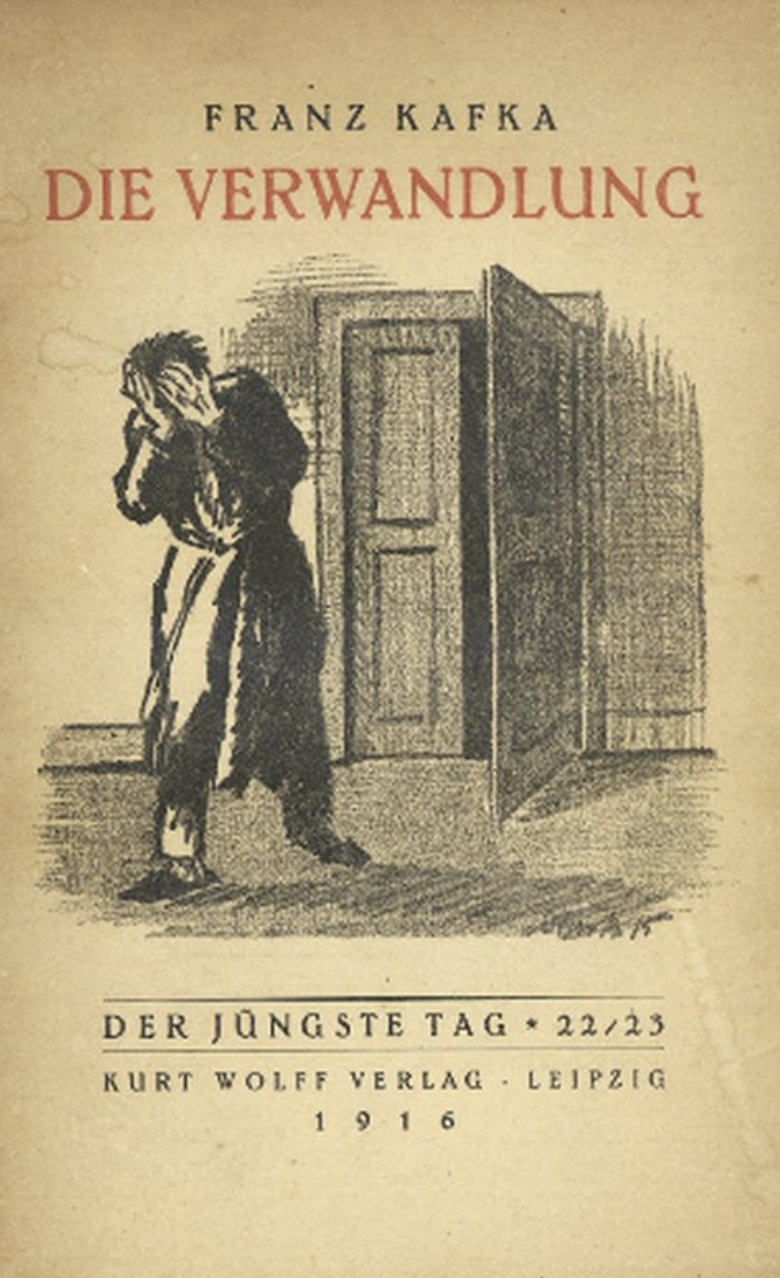
The second example is a series of illustrations by Ben Jones for a copy of the book published by Paragon Post. In the cover illustration, below, Jones has enclosed an image of Frank Kafka within a cuboid, which is likely a reference to being trapped. Layered over Kafka’s face is an illustrated insect with a human leg attached, which is also mostly confined within the cuboid, but appears to be breaking out of one side, which may link to the idea that the only way for the man to escape is to completely transform. Upon the insect’s back is a yellow target symbol, which I believe might be a reference to Gregor being the target of abuse throughout the story, whether that be emotional, physical or financial abuse. I liked the style of this illustration and I thought it conveyed plenty of tantalising information about the story. However, it is slightly amusing that a beetle is crawling over Kafka’s face when he specifically asked for one not to be depicted!
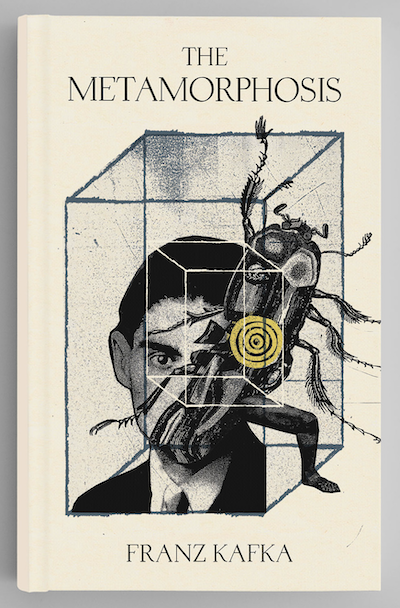
Published by Paragon Post (n.d.). Source: Heart Agency.
The next example is the cover illustration of a graphic novel version of the story, illustrated by Peter Kuper. This image shows Gregor after his transformation as a simplified beetle with a semi-human head. Although the layout of this cover appealed to me as I like the strong, graphic style and the balance of the composition, as well as the menacing shadow being cast through the entrance to the room, I felt that the style of the beetle was too cartoony and it did not fit with my impression of the story. Of course, this is due to my personal taste and reaction to the story, so I am sure it would appeal to other readers. Additionally, when considered in the context of a graphic novel, it may be a more appropriate choice of style.
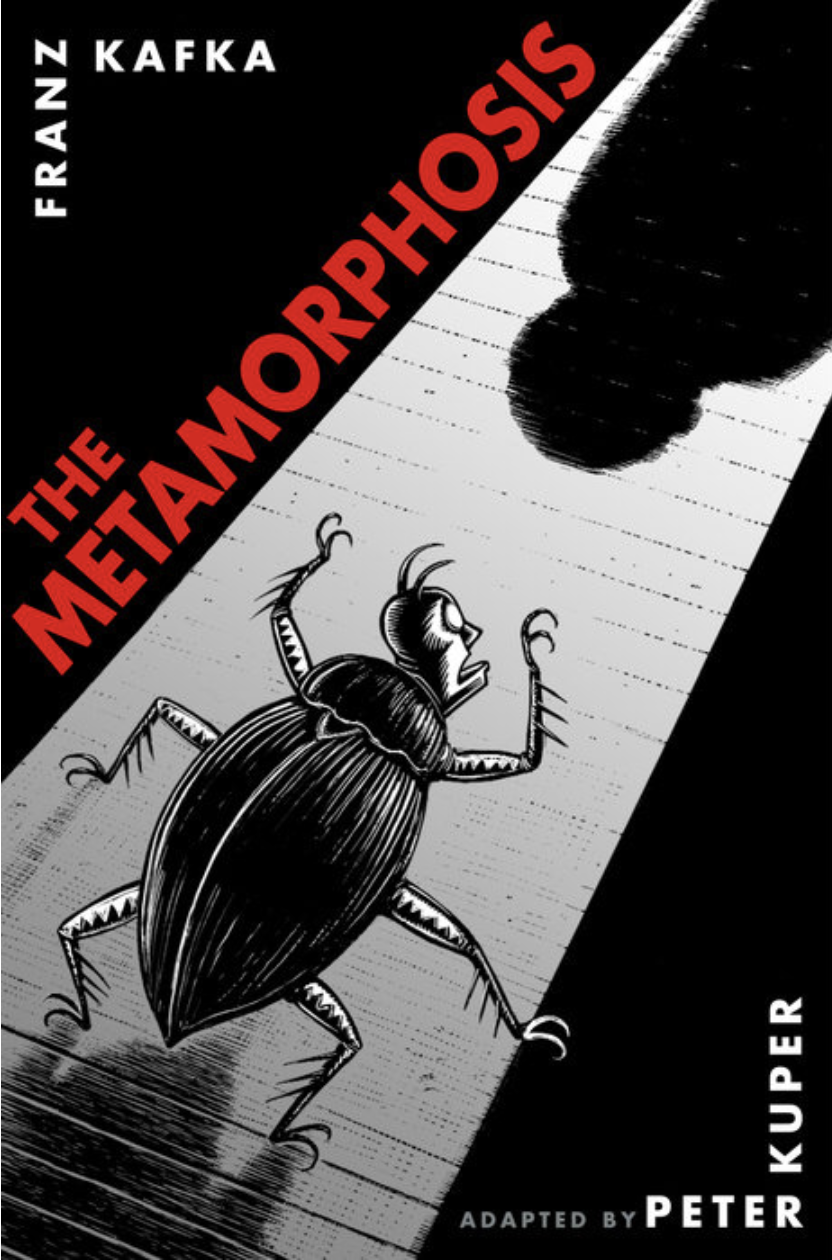
In the example below, the illustrator Hannah K. Lee has chosen to show Gregor in his human form, but his elongated limbs and awkward, cowering posture suggest that some kind of action/event is imminent. I thought this illustration demonstrated how it is possible to convey a visual message without being explicit. It makes me feel uneasy and I think the single eye staring out at the viewer is startling and evocative.
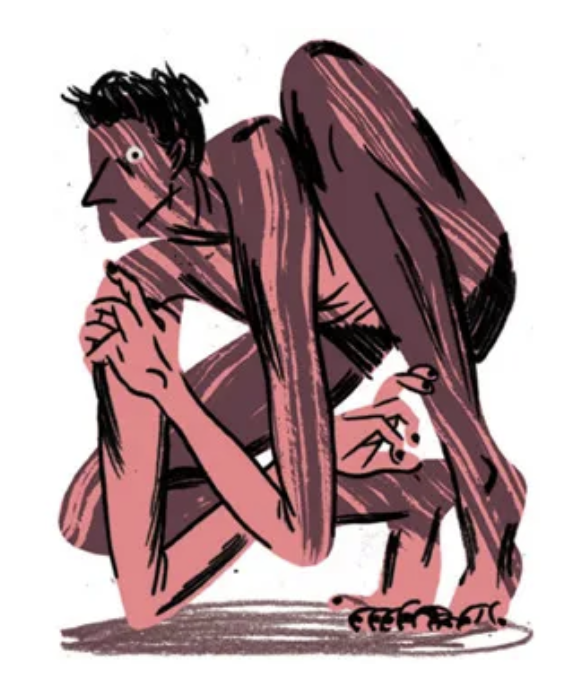
Source: The New Yorker
The final illustrator that I selected was by Bill Bragg, who created a series of illustrations for an edition of The Metamorphosis published by The Folio Society in 2010. In the cover illustration, below, Bragg has used a silhouette of a beetle-like insect layered over a patterned surface that resembles wallpaper. Although Bragg has depicted the insect, I think that using the shadow rather than the actual creature is quite effective as it still leaves room for the reader’s imagination to fill in the details.
Additionally, I felt the scale of the shadow was important in this image as it is so large it wraps around the book sleeve and the edges go beyond the cover’s borders. This implied there is an unnatural element to the story. The use of a standard wallpaper design also suggests that this extraordinary event is taking place in a mundane, everyday setting.
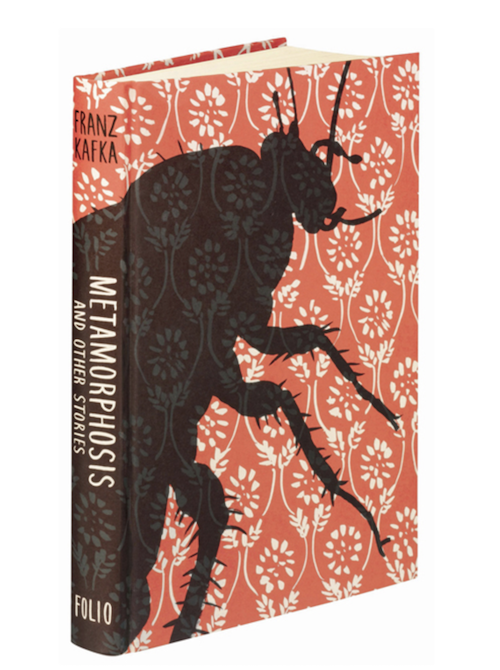
I moved away from illustration to look at other examples of visual representations of The Metamorphosis.
I discovered a series of works by the artist Miquel Barceló, two of which can be seen below. The first appears to depict the transformation stage from human into insect as the outline of the human has a series of insect-style legs protruding from the torso, which also give the appearance of the person being a pin cushion. The second painting shows Gregor after the transformation as an insect. As a side observation, the insect looks to me a bit like it has been squashed! I felt that these paintings with the crude application of paint, was an effective way of communicating the nature of the story.
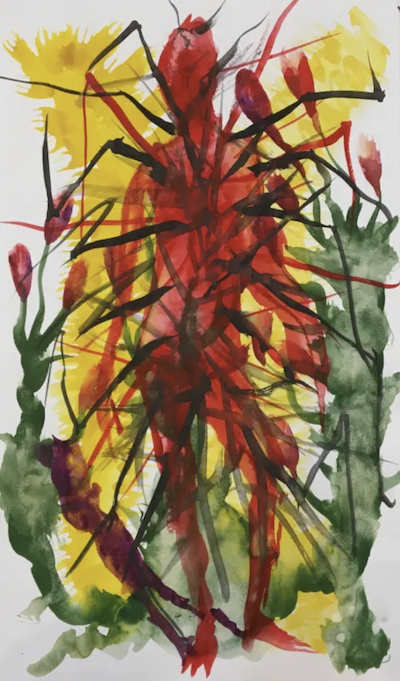
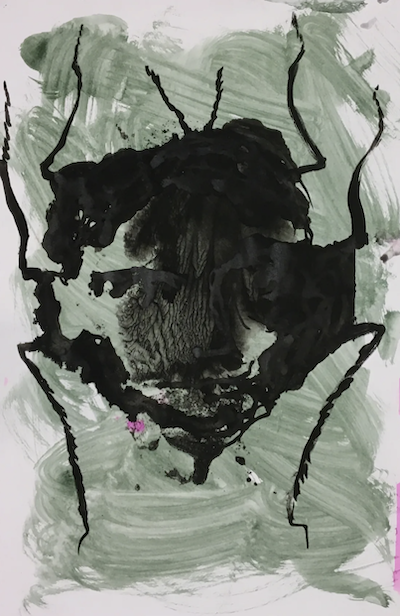
I then looked at a couple of theatre productions of the story. The first one was a dance production by The Royal Opera House, starring Edward Watson as Gregor. I think the image below show how effectively the character of Gregor was portrayed. He is clearly meant to be transformed in to an insect at this stage, but Watson does not have any costume to show this, it is merely the placement of his limbs, contorted to resemble an insect and being covered in some form of brown, tar-like substance, which is leaving traces on the surface, just as described in the text. I also thought the similarities between this image and the illustration by Hannah K. Lee, discussed earlier, were startlingly apparent.
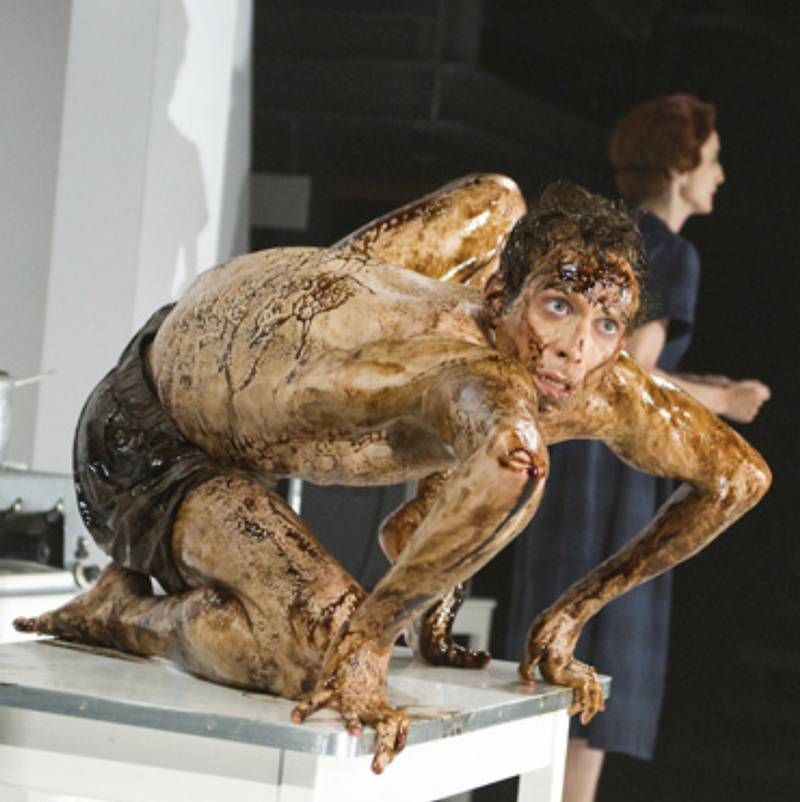
I then found details of a production by Frantic Assembly. As can be seen in the screenshot below, visuals of an insect-like creature are combined with human body parts to show the transformation in this version. Although I thought it all looked very slick, I found the previous example by the ROH to be much more convincing and compelling in its depiction of the character.
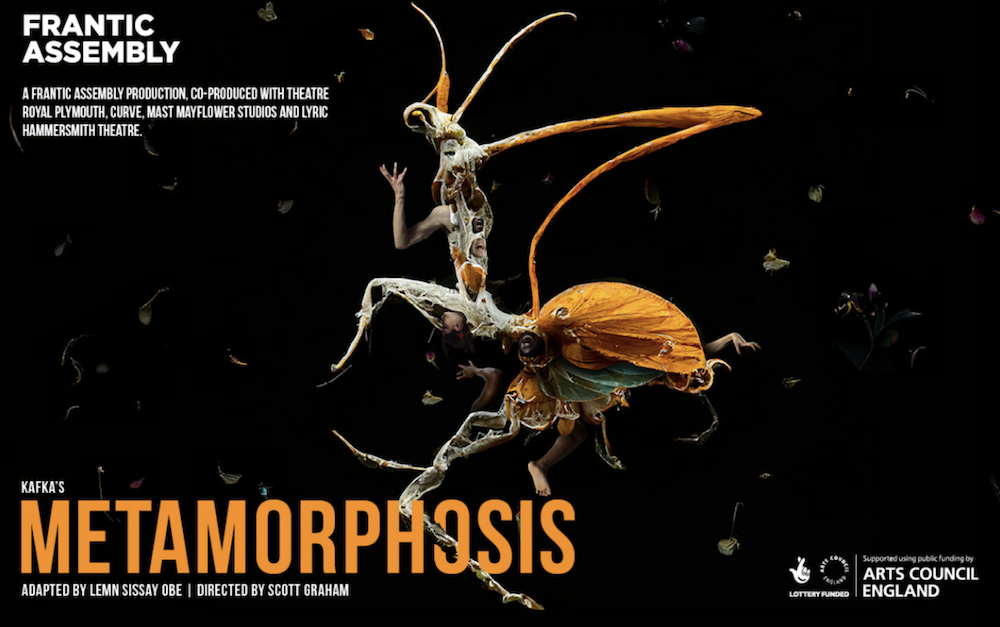
Source: Frantic Assembly.
The final selection of research I chose was of examples of The Metamorphosis depicted on screen, either TV or film. I did not watch any of these, but instead looked at trailers and/or posters advertising them.
The first example I chose was the film poster for the short film Die Verwandlung (2015), shown below. I thought this was quite a striking image with its use of various shades of white, which made it seem quite clinical in nature. The use of a curled up, foetal position for the man in the centre of the composition, suggests he is about to go through the transformation, or reborn, as implied by the title.
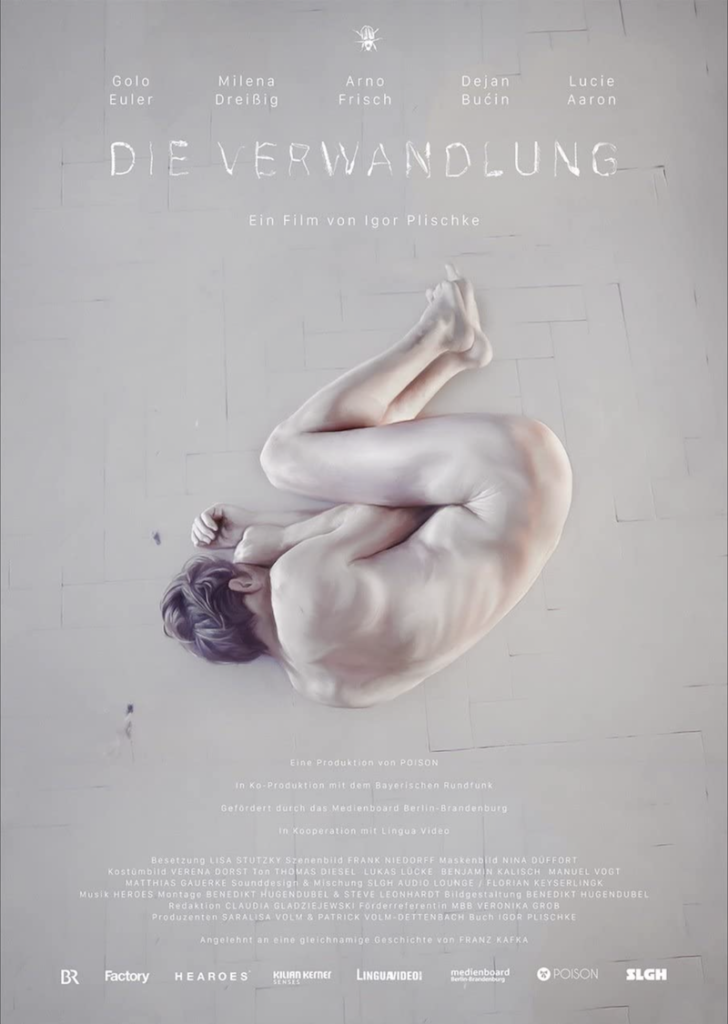
The final choice for this Research Task was the 2012 film Metamorphosis. I watched the trailer and thought is was a comedy, although I am not sure if this was intentional or not. I thought the character of Gregor when shown as a beetle was quite ridiculous and having learned of Kafka’s wishes for the story, I am not sure he would be too keen on this version.
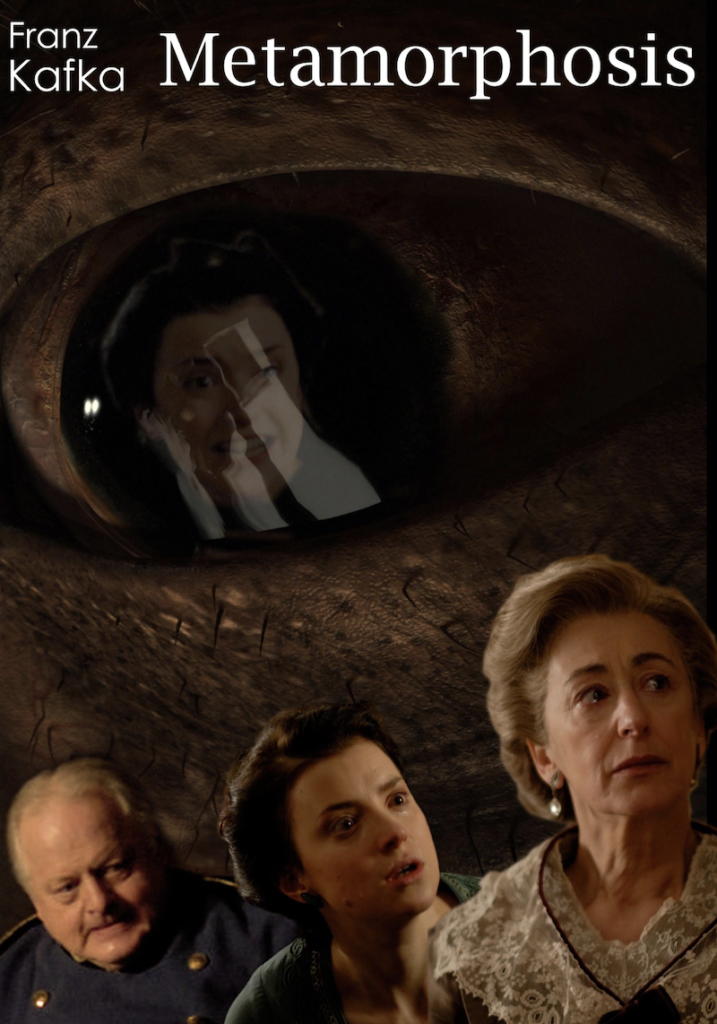
Source: IMDb.
Final Thoughts
I am very glad that I opted to read the full version of The Metamorphosis before undertaking this Research Task, as I feel this allowed me to analyse the illustrations and other visual material related to it with more confidence.
In general, I believe that it is more effective to encourage the reader or viewer to use their imagination when it comes to visual representations, particularly those such as of the insect in this story, as requested by Kafka. I also think this is relevant in horror films, for example, when the viewer has knowledge that there is a monster lurking in the darkness just around the corner, but it is the fear of the unknown that is more powerful. Once the viewer is actually confronted by a visual, after the initial reaction of shock, it often does not match their imagination and is a let-down (or a relief, depending on your disposition…).
With this in mind, I felt the most successful versions from the selection above, as previously explained, are:
- The original cover illustration from the first edition of The Metamorphosis in 1915.
- The illustration by Hannah K. Lee for The New Yorker.
- The dance production version by The Royal Opera House.
Bibliography
Bernofsky, S. (2014) On Translating Kafka’s “The Metamorphosis”. Available at: https://www.newyorker.com/books/page-turner/on-translating-kafkas-the-metamorphosis (Accessed 3 May 2023).
Frantic Assembly (n.d.) Metamorphosis. Available at: https://www.franticassembly.co.uk/productions/metamorphosis (Accessed 5 May 2023).
Heart Agency (n.d.) The Metamorphosis – Ben Jones. Available at: https://www.heartagency.com/projects/metamorphosis/?linked_artist=739 (Accessed 4 May 2023).
IMDb (n.d.) Die Verwandlung (Short 2015). Available at: https://www.imdb.com/title/tt4195258 (Accessed 5 May 2023).
IMDb (n.d.) Metamorphosis (2012). Available at: https://www.imdb.com/title/tt2319941 (Accessed 5 May 2023).
Jones, B. (n.d.) benjonesillustration. Available at: https://benjonesillustration.com (Accessed 4 May 2023).
Jones, J. (2015) Franz Kafka Says the Insect in The Metamorphosis Should Never Be Drawn; Vladimir Nabokov Draws It Anyway. Available at: https://www.openculture.com/2015/10/franz-kafka-says-the-insect-in-the-metamorphosis-should-never-be-drawn.html (Accessed 3 May 2023).
Penguin Random House (n.d.) The Metamorphosis: The Illustrated Edition. Available at: https://www.penguinrandomhouse.com/books/96229/the-metamorphosis-the-illustrated-edition-by-franz-kafka-adapted-by-peter-kuper/ (Accessed 4 May 2023).
Royal Opera House (n.d.) The Metamorphosis. Available at: https://www.roh.org.uk/tickets-and-events/the-metamorphosis-stream-details (Accessed 5 May 2023).
Thaddaeus Ropac (n.d.) Miquel Barceló exhibits his watercolours based on Kafka’s “The Metamorphosis”. On view at Gallimard Gallery. Available at: https://ropac.net/news/670-miquel-barcelo-exhibits-his-watercolors-based-on-kafka-s-on-view-at-gallimard-gallery/ (Accessed 5 May 2023).
Wikipedia (n.d.) The Metamorphosis. Available at: https://en.wikipedia.org/wiki/The_Metamorphosis (Accessed 3 May 2023).